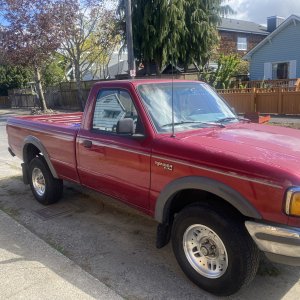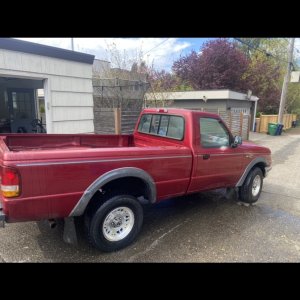Attempting to correct misconceptions from actual design issues.
A gooseneck hitch is the same ball and socket as a "bumper" hitch; both have limited ability to resist "lifting" forces. As a result, both have to have chains as a secondary method of attachment. On the other hand, your trailer should have >10% of its weight on the "ball". Therefore, for on-road conditions, there should be limited cases where there is no weight on the ball - so long as there is weight on the ball, the hitch and/or the ball have to fail before the hitch disengages.
On the other hand, a 5th wheel hitch, surround the joining surface of the pin with >200* of securing surface. The result is the pin can resist >12k lbs (SAE spec J133) of vertical for 100k cycles) As a result, safety chains are
not required when 5th wheel is used.
@Rick W is proposing inverting the hitch, the ball
and the loads, as a result, the weight of the trailer will be on the socket of the hitch just like a normal trailer, and the "tensioner" will have the exact same function/loads as a normal trailer. Bass ackards but it works.
My concerns are regarding the removing of the frame rear crossmember - it keeps the rear spring mounts the correct distance apart drive "spirited" cornering. One doesn't want the rear frame to fold should Rick accidently slide into a curb.
I also don't see in the pictures how Rick has attached the crossmember to which he is attaching his rear axle brackets/suspension. Ford uses 8 - 1/2" rivets spread over 6" x 4" pattern at the front to minimize load concentrations.
I also don't like battery and filler in close proximity....I'd sooner the battery was in a vented compartment on other side of the truck.
Remove the crossmember: I understand the concern here, concerned me too. I have an earlier picture but can’t find it at the moment. From memory, I added 5-6 angle iron braces between the frame rails before and aft of the top member mount, high low and in between. Bolted to allow that smidge of motion like rivets. I’m confident it matches or exceeds the original crossmember support, but allows for the ball Mount to end up between the frame rails and float.
Attachment: again, this design is a floating 4-link that drags behind the drive axle and truck, it’s not under the truck mounted to the frame supporting the truck. The attachments and members are trailer-like, all class III or class IV rated parts or similar.
I used a 2x2x1/4” square stock between the frame rails, 3/8” flanges welded on both ends, bolted through the frame w/ 5/8” bolts. Under that are hangers just like you’d mount trailer spring. The top link is a 2x4 trailer tongue that is welded to the bottom of the cut-out center of a class III receiver so I can use a regular 2” trailer hitch out the back.
The bottom “links” are the 1,750# leaf springs holding a 3,500# axle. They’re mounted like trailer springs to holders bolted under the frame (two+ 1/2” or 5/8” bolts each). Between the receiver mentioned and the springs are about 6-7” shackles, mounted like you would on a trailer axle, but I used 1-1/2” x 1/4” angle iron to secure against warping.
Since the entire thing pivots up and down and floats behind and underneath the truck/frame. If I spun into a curb, it might deform UNDER the truck frame, but very hard for me to believe it would entirely break loose.
On top of the top members, I used parts from a class IV bolt together receiver. From an E-350 van. I mounted the end brackets that would normally bolt below a frame to the top of the top members of the 4 link. Instead of the center section, I used another piece of 2x2x1/4 square stock. The ball end of the coupler (a good one BTW, not cheap) is welded into that square stock, and also bolted via an added extended flange. The wide end is bolted to the top of the rear lower receiver with 2x4 rectangular stock spacer to keep it level. The ball socket takes the load, the tail is simply supported to prevent pivoting and metal fatigue.
The location and configuration was to place the ball socket between the frame rails, no force up or down, just longitudinal on the frame, forward and back.
Fill neck: there is a double sleeve around the fill tube, and that is reinforced with tire sidewall rubber padding everywhere it does or might rub. The tool box breathes, but I’m planning even more ventilation.
One oversight was that the drain on the gas cap assembly originally drained under the truck for spillage. I may add that later, but for now I sealed the drain and modified the assembly so and filling spillage pours out, not down.
I agree with everyone on what would be the best hitches and alternatives. And with all modesty, budget is not an issue for me. The nature of the project, almost like an art project, is to be creative and functional with the least expense and intentionally unusual creative junk all for fun. If this was going to be a “work horse” I’d never be doing it this way.
And don’t think for a second I don’t take all of this into consideration. You’ve got me thinking of adding across peace behind the bowl as a back up for the tensioner. I’ll be looking at that when I do the tongue of the trailer.














